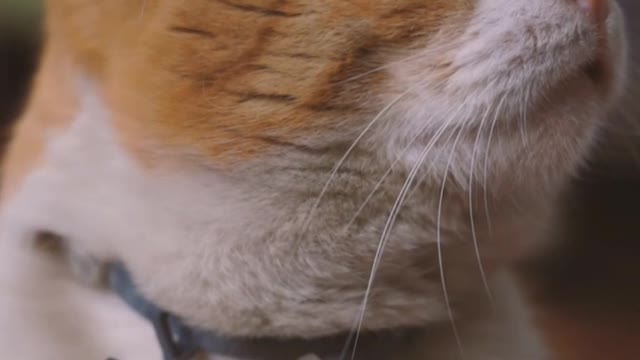Premium Only Content

Vision, smell, test and hearing are more powerful than humans.
Cats have excellent night vision and can see at only one-sixth the light level required for human vision.[64]: 43 This is partly the result of cat eyes having a tapetum lucidum, which reflects any light that passes through the retina back into the eye, thereby increasing the eye's sensitivity to dim light.[77] Large pupils are an adaptation to dim light. The domestic cat has slit pupils, which allow it to focus bright light without chromatic aberration.[78] At low light, a cat's pupils expand to cover most of the exposed surface of its eyes.[79] The domestic cat has rather poor color vision and only two types of cone cells, optimized for sensitivity to blue and yellowish green; its ability to distinguish between red and green is limited.[80] A response to middle wavelengths from a system other than the rod cells might be due to a third type of cone. This appears to be an adaptation to low light levels rather than representing true trichromatic vision.[81]
Hearing
The domestic cat's hearing is most acute in the range of 500 Hz to 32 kHz.[82] It can detect an extremely broad range of frequencies ranging from 55 Hz to 79,000 Hz. It can hear a range of 10.5 octaves, while humans and dogs can hear ranges of about 9 octaves.[83][84] Its hearing sensitivity is enhanced by its large movable outer ears, the pinnae, which amplify sounds and help detect the location of a noise. It can detect ultrasound, which enables it to detect ultrasonic calls made by rodent prey.[85][86] Recent research has shown that cats have socio-spatial cognitive abilities to create mental maps of owners' locations based on hearing owners' voices.[87]
Smell
Cats have an acute sense of smell, due in part to their well-developed olfactory bulb and a large surface of olfactory mucosa, about 5.8 square centimetres (29⁄32 square inch) in area, which is about twice that of humans.[88] Cats and many other animals have a Jacobson's organ in their mouths that is used in the behavioral process of flehmening. It allows them to sense certain aromas in a way that humans cannot. Cats are sensitive to pheromones such as 3-mercapto-3-methylbutan-1-ol,[89] which they use to communicate through urine spraying and marking with scent glands.[90] Many cats also respond strongly to plants that contain nepetalactone, especially catnip, as they can detect that substance at less than one part per billion.[91] About 70–80% of cats are affected by nepetalactone.[92] This response is also produced by other plants, such as silver vine (Actinidia polygama) and the herb valerian; it may be caused by the smell of these plants mimicking a pheromone and stimulating cats' social or sexual behaviors.[93]
Taste
Cats have relatively few taste buds compared to humans (470 or so versus more than 9,000 on the human tongue).[94] Domestic and wild cats share a taste receptor gene mutation that keeps their sweet taste buds from binding to sugary molecules, leaving them with no ability to taste sweetness.[95] Their taste buds instead respond to acids, amino acids like protein, and bitter tastes.[96] Cats also have a distinct temperature preference for their food, preferring food with a temperature around 38 °C (100 °F) which is similar to that of a fresh kill and routinely rejecting food presented cold or refrigerated (which would signal to the cat that the "prey" item is long dead and therefore possibly toxic or decomposing).[94]
Whiskers
The whiskers of a cat are highly sensitive to touch
To aid with navigation and sensation, cats have dozens of movable whiskers (vibrissae) over their body, especially their faces. These provide information on the width of gaps and on the location of objects in the dark, both by touching objects directly and by sensing air currents; they also trigger protective blink reflexes to protect the eyes from damage.
-
 LIVE
LIVE
Dr Disrespect
6 hours ago🔴LIVE - DR DISRESPECT - ARC RAIDERS - NORTH LINE UPDATE
1,508 watching -
 8:10
8:10
Buddy Brown
5 hours ago $0.37 earned5 Things Your Pastor WON'T TEACH YOU at Church! | Buddy Brown
3795 -
 LIVE
LIVE
LFA TV
19 hours agoLIVE & BREAKING NEWS! | THURSDAY 11/13/25
1,417 watching -
 LIVE
LIVE
freecastle
6 hours agoTAKE UP YOUR CROSS- Commit your way to the Lord; trust in him, and he will act!
82 watching -
 30:28
30:28
The White House
6 hours agoPresident Trump and the First Lady Participate in an Executive Order Signing
20.9K20 -
 1:13:56
1:13:56
DeVory Darkins
4 hours agoNewsom SUFFERS MAJOR SETBACK after Trump revokes 17,000 Commercial Drivers Licenses
145K61 -
 1:07:32
1:07:32
Timcast
5 hours agoDemocrats CAUGHT Framing Trump On Epstein, Leaked Emails Show Journalist COLLUSION :+1: 1
175K197 -
 LIVE
LIVE
The Bold Lib
3 hours agoBOLDCHAT: Moms For Liberty | Free Speech w/ANGELA BELCAMINO
56 watching -
 2:11:09
2:11:09
Steven Crowder
8 hours ago🔴 Just Release the Damn Epstein Files - End It Once and For All
527K426 -
 10:06
10:06
VSOGunChannel
4 hours ago $2.29 earnedCongress Tells ATF to Stop Doing the National Firearms Act
18K2